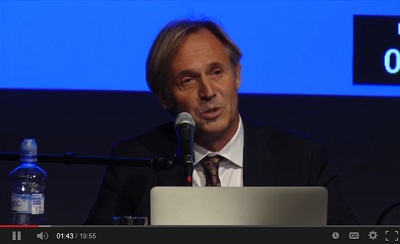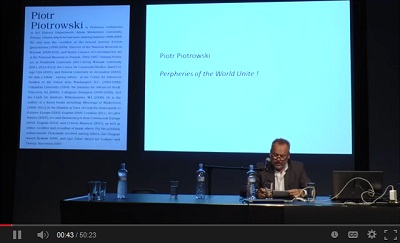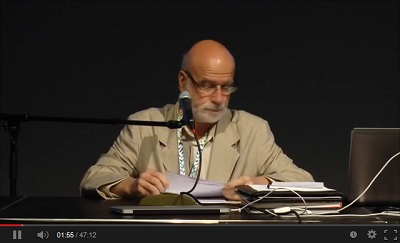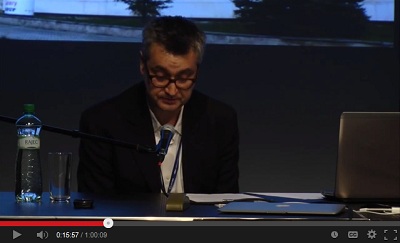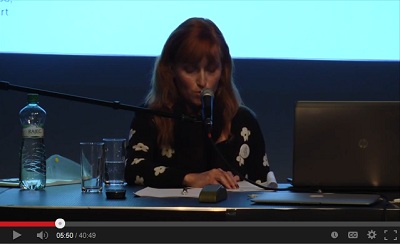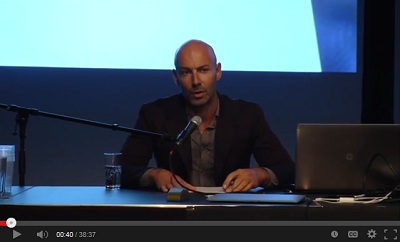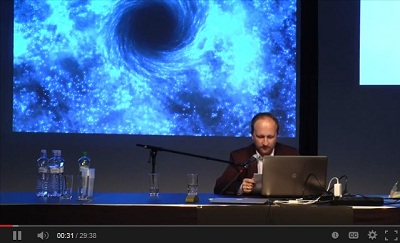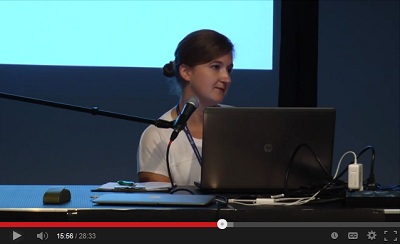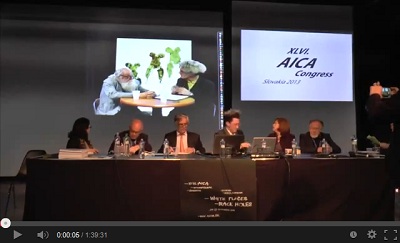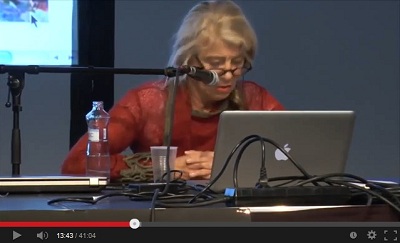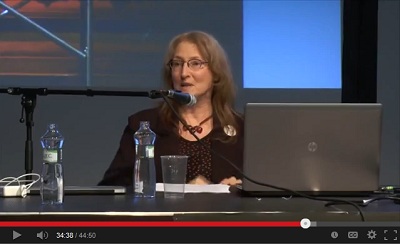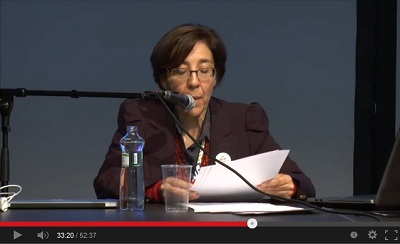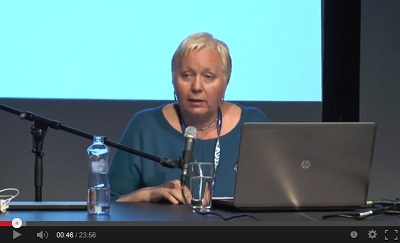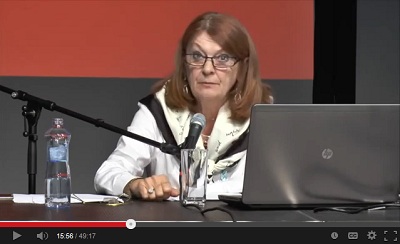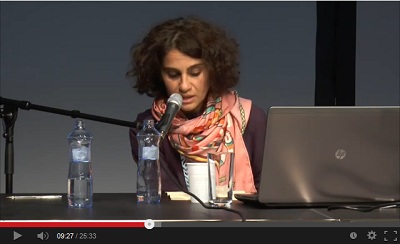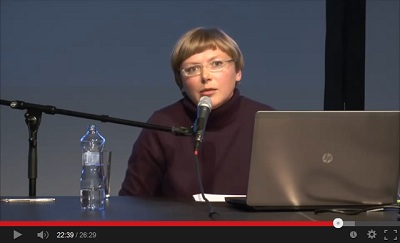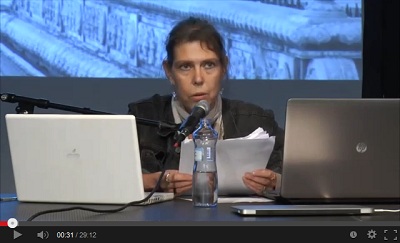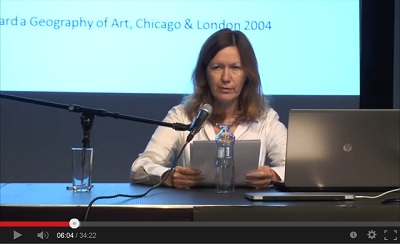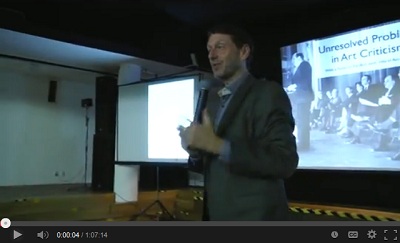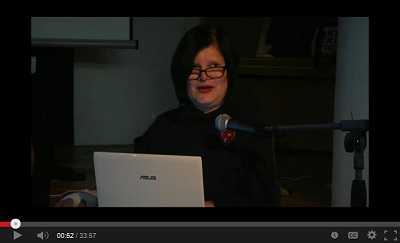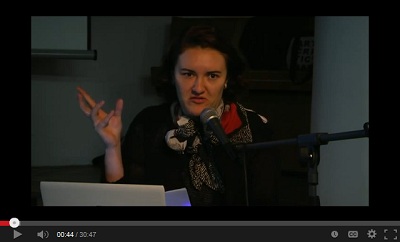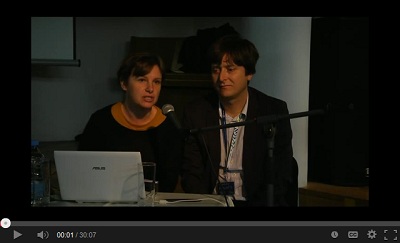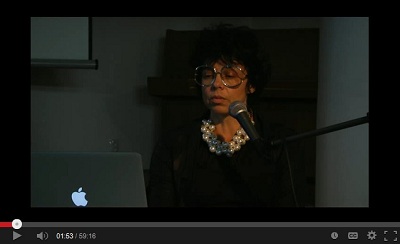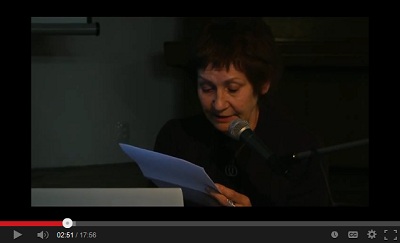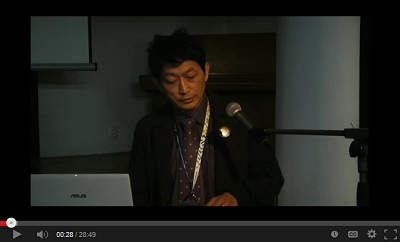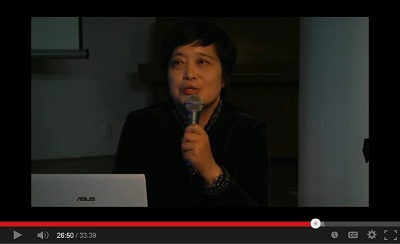Congress Day 1
The first and second day of the congress will be devoted to a return to history, with analyses and criticisms of the ways in which regions have been preceived in the dominant history of art in past decades. To the present date the question has not been addressed: in the context of this history, how can the specific value and originality of the art of local scenes be defined, without applying a colonial or other distorted perspective? A special sub-theme will be devoted to Pierre Restany and his international activities, specifically his relations with central europe or other regions outside France.
Welcome speech by Juraj Čarný, Marek Bartelik, Marjorie Allthorpe Guyton and letter from UNESCO Director General Irina Bokova
Welcome speech by Juraj Carny
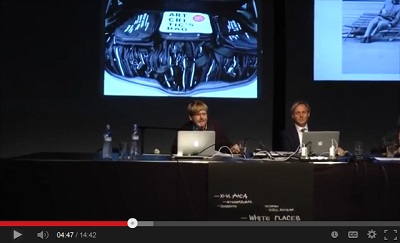
video in french
video in spanish
Opening speech by Marek Bartelik
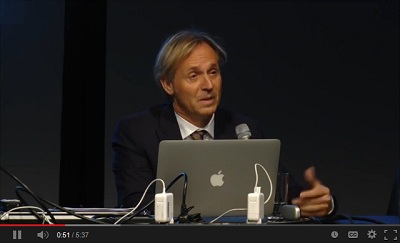
video in french
video in spanish
Letter from UNESCO Director General Irina Bokova
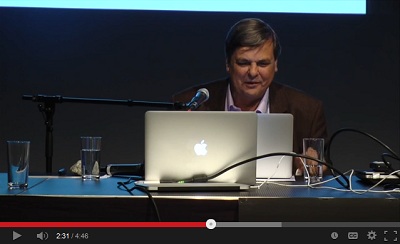
video in french
video in spanish
Opening speech by Marjorie Allthorpe Guyton
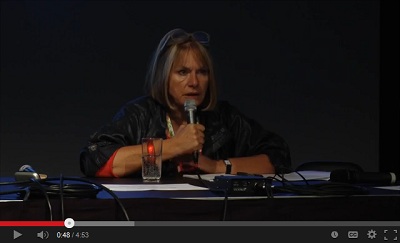
video in french
video in spanish
Introduction by Marek Bartelik
Piotr Piotrowski
is Professor ordinarius at Art History Department, Adam Mickiewicz University, Poznan, Poland, which he has been chairing between 1999-2008. He also was the co-editor of the annual journal Artium Quaestiones (1994-2009), Director of the National Museum in Warsaw, 2009-2010, and Senior Curator of Contemporary Art at the National Museum in Poznan, 1992-1997. Visiting Professor at Humboldt University (2011-2012), Warsaw University (2011, 2012-2013), the Center for Curatorial Studies, Bard College USA (2001), and Hebrew University in Jerusalem (2003). He was a fellow - among others - at the Center for Advanced Studies in the Visual Arts, Washington D.C. (1989-1990), Columbia University (1994), the Institute for Advanced Study, Princeton NJ (2000), Collegium Budapest (2005-2006), and the Clark Art Institute, Williamstown, MA (2009). He is the author of a dozen books including: Meanings of Modernism (1999, 2011), In the Shadow of Yalta. Art and the Avant-garde in Eastern Europe (2005, English 2009, Croatian 2011), Art after Politics (2007), Art and Democracy in Post-Communist Europe (2010, English 2012), and Critical Museum (2011), as well as editor, co-editor and co-author of many others. For his scholarly achievements Piotrowski received among others Jan Dlugosz Award Krakow 2006, and Igor Zabel Award for Culture and Theory, Barcelona 2010.
László Beke
Prof. Dr., dr. habil. (born 1944, Szombathely, Hungary) is ex-director of the Research Institute of Art History of the Hungarian Academy of Sciences (Budapest), Professor at the Hungarian University of Fine Arts and teaches in several Hungarian institutions. He had been teaching at the University of Lyon 2 – Louis Lumiere (1988-89) and was Chief Curator of the 19th and 20th Centuries Collections at the Hungarian National Gallery (from 1988 to1995) and General Director of Műcsarnok/Kunsthalle in Budapest. He was curator of numerous exhibitions, has written texts and published books on art, 20th century theory and contemporary times. Ex-ordinary member of the Hungarian National Committee of CIHA. Member of the Hungarian section of AICA.
Tomáš Pospiszyl
(*1967) is a Czech critic, curator and art historian. He studied at Charles University in Prague and Bard College in New York. He worked as a curator at The National Gallery in Prague (1997-2002), and was a research fellow at The Museum of Modern Art in New York (2000). Since 2003 he teaches Art History at the Film and TV School of the Academy of Performing Arts in Prague and since 2012 at the Academy of Fine Arts in Prague. Projects authored by Tomas Pospiszyl range from period of early modernism, mid 20th century avant-garde to contemporary art. He is particularly interested in popular culture (book Octobriana and Russian Underground, 2004, book and exhibition Planet Eden, 2010) and art created during the Cold War on both sides of the Iron Curtain (collection of essays Comparative Studies, 2005). He serves at the board of tranzit.cz, an art initiative in the Czech Republic, for which he prepared exhibitions, lectures and public programs, currently performative exhibition Július Koller Archive: Study Room. His publications in English include, among others, an anthology Primary Documents; A Sourcebook for Eastern and Central European Art since the 1950s., which he edited together with Laura Hoptman, (MIT Press, MoMA, 2002).
Richard Gregor
(*1974) is historian, curator, and art critic. Studied at Trnava University and at Charles University in Prague. He has worked as chief curator at Nitra Gallery and Bratislava City Gallery, lectured in the Department of Art Theory and History at the Academy of Art in Banská Bystrica, and served as an independent expert on questions concerning galleries at the Ministry of Culture of the Slovak Republic. He has curated more than thirty exhibitions at home and abroad, and has written reviews and essays. Founder of the journal Jazdec – a noticeboard for current activity in the arts, he is also the creator of the web-archive www.artdispecing.sk. Former president of the Council of Slovak Galleries, current vice-president of the Slovak Section of the International Association of Art Critics (AICA), member of the College Art Association. He regularly participates in conferences and seminars, has lectured in Slovakia, Czech Republic, Austria, Hungary and the USA, and has had stipendiary stays in the USA, Great Britain, Denmark and Israel. In 2008, on his initiative, the Cyprián Majerník Gallery in Bratislava (originally founded in 1957) was re-established. He is currently its director. His book Haberernová’s Eye. Post-Informal Figuration in Slovak Visual Art of 1960s was published in 2013.
Beata Jablonská
I have been working as a pedagogue at the Academy od Fine Arts in Bratislava. I am writing a dissertation on Painting in Concept. Critical research the conceptual practises in painting after 1960. I studied the Theory and history of fine arts at Comenius University in Bratislava (1986-1991). Until 2009 I worked as a curator of drawings collections 20 century- the Slovak National Gallery in Bratislava. I am the author of chapters Painting in postmodern situation in synthetic publication 20th century (Slovak National Gallery, 2000), chapter Lies, dilemmas and alternatives image in the catalog Slovak visual art from 1970 to 1985 (Slovak National Gallery, 2003). I was editor and curator of the exhibition and the catalog of the exhibition Eighties. Postmodernism in the Visual Arts 1985-1992 (Slovak National Gallery, 2009).
Igor Španjol
was born in 1972, lives and works in Ljubljana, Slovenia. Studied sociology of culture and art history at the Faculty of Arts in Ljubljana. Since 1999 works as a curator at the Moderna galerija Ljubljana/Museum of Modern Art. Most important collaborative projects: exhibition trilogy Slovene Art 1975–2005 at the Moderna galerija (co-curated with Igor Zabel, 2003-2005) series of exhibitions in Moderna galerija’s project space Mala galerija (Andrei Monastirsky, Danica Dakić, Harun Farocki, Deimantas Narkevičius, Silvia Kolbowski and David Maljković among others, 2007-2009) and retrospectives of Marko Peljhan (2010) and Marko Pogačnik (2012).
Andrzej Szczerski
(1971) is assisant profesor in Institute of Art History, Jagiellonian University in Krakow. Visiting lecturer at the Goethe University in Frankfurt (2003) and St Andrews University (2004). Author of “Patterns of Identity. The Reception of British Art in Central Europe Around 1900” (Kraków 2002) and “Modernizations. Art and Architecture in the new states of Central-Easter Europe 1918-1939” (Łódź 2010). Curator of exhibition “Modernizations. The Future Perfect 1918-1939” at the Museum of Art in Łódź (2010), co-curator of exhibitions “Symbolism in Poland and Britain” at the Tate Britain in London (2009) and “The Power of Fantasy. Modern and Contemporary Art from Poland” at the BOZAR Palais of Art in Brussels (2011). 2012-2013 advisor to Ministry of Culture and National Heritage in Warsaw on national and regional collections of contemporary art. Since 2009 president of Polish Section of International Association of Art Critics AICA.
Katarzyna Jagodzińska
Ph.D. in Art History (2012). Graduate of Art History (M.A.) and Journalism and Communication (B.A., M.A.), Jagiellonian University, Krakow. Her academic research deals with museum studies, especially in the region of Central Europe – the title of her doctoral thesis: Museums, galleries and centres of contemporary art in Central Europe (1989-2009). She delivered papers and presentations at numerous academic conferences worldwide, including the 32nd Congress of CIHA in Melbourne (2008), 22nd ICOM General Conference in Shanghai (2010), The Making of National Museums and Identity Politics in Taipei (2011), 33rd Congress of CIHA in Nuremberg (2012). She is an author of over 60 articles in the field of museums and art history in academic and specialist magazines, member of the editorial team of the HERITO quarterly and local editor of the RIHA Journal – international academic journal of art history, member of ICOM, AICA and Association of Art Historians in Poland. Art critic and curator. She works in the International Cultural Centre in Krakow and in the Institute of European Studies, Jagiellonian University.
Congress Day 2
The first and second day of the congress will be devoted to a return to history, with analyses and criticisms of the ways in which regions have been preceived in the dominant history of art in past decades. To the present date the question has not been addressed: in the context of this history, how can the specific value and originality of the art of local scenes be defined, without applying a colonial or other distorted perspective? A special sub-theme will be devoted to Pierre Restany and his international activities, specifically his relations with central europe or other regions outside France.
Round Table – Honour to Pierre Restany
Zuzana Bartošová (SK), Rebollo Goncalves Lisbeth (BR), Raphael Cuir (F), Henry Meyric Hughes (UK), Alex Mlynárčik (SK), Henry Perier (F) Jean - Marc Poinsot (F)
Noemi Smolik
was born in former Czechoslovakia and raised in Prague. She studied Art History, History and Philosophy in Cologne and New York and wrote her doctoral dissertation at the University of Cologne on the development of non-objective painting in Russia, using the example of Wassily Kandinsky. She has since published numerous texts on the topic of the Russian Avant-garde in the early 20th century in, among others the Frankfurter Allgemeine Zeitung and the English art magazine frieze, as well as in exhibition catalogues for institutions such as the Tate Modern in London, the Kunstmuseum Basel, the Centre Pompidou in Paris and the Lenbachhaus in Munich. She has held chairs as Professor and Visiting Professor of Art History and Art Theory at the Universities of Fine Art in Hamburg and Dresden, the Alanus University of Arts and Sciences in Bonn and the University of Cologne. Since 2010, she has been teaching Art Theory and Criticism at the University of Bonn. Since 2007, she has chaired a practical seminar in art criticism at the Montag Foundation in Bonn and, since 2011, at the Arthena Foundation in Düsseldorf. Her texts on the Russian Avant-garde and contemporary art appear regularly in the Frankfurter Allgemeine Zeitung, artforum and aperture (both New York), frieze (London); frieze d/e (Berlin), artblog-cologne and the Czech newspaper Mladaf fronta Dnes (Prague). She lives and works in Bonn and Prague.
Karen Von Veh
Prof, is Associate Professor of art history in the Visual Arts Department at the University of Johannesburg, South Africa. Karen is the past president ex officio of SAVAH (the South African Visual Arts Historians association) and is on the board of directors of ACASA (Arts Council of the African Studies Association). In addition she is a member of CIHA (Comité National d’Histoire de l’Art) and CAA (College Art Association). Her research interests include contemporary South African Art, the transgressive use of religious (Christian) iconography, postcolonial studies and gender studies. She has written several articles in academic journals and chapters in books on these subjects, as well as two monographs on South African artist Diane Victor: Diane Victor: Burning the Candle at Both Ends, 2012 and Taxi 13: Diane Victor, 2008 (the latter co-written with Prof. Elizabeth Rankin from Auckland University).
Trinidad Pérez
is an Ecuadorian art historian who is currently professor and researcher at FLACSO-Ecuador (Facultad Latinoamericana de Ciencias Sociales), a graduate university system where she has designed a Masters of Fine Arts Program. She has previously taught and directed the art history program at Universidad San Francisco the Quito. She received a BA from the University of Maryland and an MA from the University of Texas at Austin, both in art history. She holds a PhD in Cultural Studies from Universidad Andina Simón Bolívar in Quito. Her research and publications focus on the emergence of modern art as an institution in Ecuador: the local and international conditions that made it possible, the roll of education, theory and institutions, and the way this art deals with national identity. During the nineties she wrote art criticism in local journals and newspapers. She has been juror in several art contests locally and in other Latin American countries.
Veerle Poupeye
is a Belgium-born, Jamaica-based art historian and curator specialized in Caribbean art. She holds an MA in Art History from the Universiteit Gent and a PhD in Cultural Studies and Art History from Emory University. Her publications include Caribbean Art (1998), which was published in Thames and Hudson’s World of Art series. She is currently Executive Director of the National Gallery of Jamaica, where she has previously worked as a curator.
Elaine King
is a freelance art critic and curator as well as a professor of Art History/Theory, Critical Studies and Museum Studies at Carnegie Mellon University. She has an interest in how technology is affecting shifts in social values, ethics and art, as well as criteria in art criticism. In September 2006, Allworth Press published Ethics and the Visual Arts that she and Gail Levin co-edited. She is finishing a book titled "Strange Bedfellows: he Relationship of Post- Modern Art and The Arts Endowment."She has written for several publications including Sculpture, Art on Paper, Art Papers, Grapheion, The Pittsburgh Post-Gazette, and The Washington Post. King was the Executive Director of the Carnegie Mellon Art Gallery and the Executive Director and Chief Curator of the Contemporary Arts Center in Cincinnati. The exhibitions she curated at both institutions include the works of Barry Le Va, Mel Bochner, Elizabeth Murray, New York: New Generation, Chicago: New Generations, Nancy Spero's Black Paintings, along with 40+ other shows. Additionally she has curated a special show for the Hungarian Graphic Arts Biennial in Gyór, the Maria Mater O’Neill exhibition at Museo of Art Puerto Rico in 2007, as well as at the Mattress Factory in Pittsburgh, "Likeness: After Warhol's Legacy” in 2009. King was the distinguished visiting professor for American University in Corciano, Italy in 2006 and held a research fellowship at the American Art Museum of the Smithsonian Institution. In 2002, she was awarded the Certificate of Fine Arts and Decorative Arts Appraisal New York University. King was awarded her interdisciplinary PhD. from Northwestern University.
Nini Palavandishvili
was born and raised in Tbilisi, Georgia. After studying Art Historyin Tbilisi, she graduated from the UdK Berlin in Faculty of Public and IndustrialCommunication. After returning back to Georgia she worked as graphic designer fordiverse advertising companies, cultural institutions, media and book publishers. Designing catalogues for exhibitions and individual artists led her way back to visual art and artist community. In 2006 Nini joined artist initiative GeoAIR and since then she is actively engaged in curating and organizing international exchange projects in Georgia and beyond its borders. Nini Palavandishvili is also a coordinator of an art residency program launched by GeoAIR in January 2010 in Tbilisi, Georgia. Through her projects Nini researches on social and political contexts and itsinterpretation in the context of cultural production and contemporary art. She is interested in artistic practice that gives innovative forms and finds a language with which it is possible to speak about political and social matters.
Lena Prents
is an independent art historian and curator. After studying German Philology at the Linguistic University in Minsk and Art History and German Literature at the Free University of Berlin, she worked for the German Guggenheim Berlin, the Bauhaus Museum Weimar and the Museum for Contemporary Art Leipzig. Her work focuses on the interrelation of art and exhibition practice in connection with socio-political discourses. She is currently working on her PhD dissertation on socialist modernist architecture in contemporary art. Since 2006 Lena Prents has been teaching at the European Humanities University in Vilnius, a Belarusian university in exile. She lives in Berlin.
Belinda Grace Gardner
M.A., b. 1960 in Durham, North Carolina, U.S.A. Studied literature and linguistics in Göttingen, Germany, and Chapel Hill, North Carolina. Has been living in Hamburg, Germany, since 1990 publishing extensively as an arts editor, freelance art critic, and author for various newspapers, magazines, and radio stations, and working as an independent curator and lecturer of art theory (currently at the University of Fine Arts, Hamburg, and the Leuphana University Lüneburg). Areas of research: pictorial constructions of romantic love from the Renaissance to the present, (post-)surreal juxtapositions as counter-images in the post-digital era, sociopolitical strategies as subversive art practices in shifting societies, (post-)existentialist manifestations of the ephemeral, and the deeper dimensions of popular and ‘low’ culture in current art. (Memberships: AICA, Germany, and German Journalists’ Union – dju)
Nadja Zgonik
PhD, is Associate Professor of Art History at the Academy of Fine Arts and Design of the University of Ljubljana, Slovenia. She also works as an independent curator and art critic. Her major topic is Slovene modern and contemporary art, particularly the issues surrounding its identities, whether national, social and political. Her major exhibitions include Wise Hand: Art – Science – Technology (Rihard Jakopič Gallery, Ljubljana, 1997) and The Cabinet of Found Objects – Exhibition of Artist's Personal Fetishes (Piran Coastal Galleries – Gallery Loggia, Koper, 1997). In 2003, she curated the exhibition The Different Same (with Zhu Tong) at the Duolun Museum of Modern Art in Shanghai, and exhibition Identikit, the first international exhibition of contemporary art the Muslim Mulliqi Award in The Kosova Art Gallery in Prishtina (with Gani Llalloshi). In 2011 she was a curator of the pavilion of the Republic of Slovenia at 54th Venice Biennale. As a curator she was invited to collaborate with the Museum of Modern Art in Ljubljana, the Maribor Art Gallery, the Piran Coastal Galleries and other museums and galleries. She organised exhibitions of Slovene art in Brussels, Voipaala, Bonn, Bologna, Venice and Trieste. She was one of the founders and the first editor-in-chief of M'ars, the magazine of the Museum of Modern Art in Ljubljana. She is the author of monographs on painters Zdenko Huzjan (2001), Žarko Vrezec (2004) and Marij Pregelj (2007). Her book on Marij Pregelj: a Drawing into a Painting was published in 1994, followed by Images of the Slovene National Identity in 2002 and Studies in Slovene Modern Art since 1945 in 2010. She was the editor-in-chief of a book Glossary of Slovene Art since 1945: Terms, Movements, Groups, Tendencies. She is a member of AICA and PEN.
Congress Day 3
Art criticism is privileged not only to reflect on the past but also to anticipate the future. The theme of the day will be devoted to analyses of the changes in the perception of art caused by the new communication schemes. Also discussed will be the means by which art criticism can come to terms with these changes (google curating, permanent online status, multi sharing, social networks and art criticism). What new social tasks and status will criticism have in the future?
James Elkins
got a graduate degree in painting, and then switched to Art History, got another graduate degree, and went on to do the PhD in Art History, which he finished in 1989. (All from the University of Chicago.) Since then he has been teaching at the School of the Art Institute of Chicago. He is currently E.C. Chadbourne Chair in the Department of Art History, Theory, and Criticism. His writing focuses on the history and theory of images in art, science, and nature. Some of his books are exclusively on fine art (What Painting Is, Why Are Our Pictures Puzzles?). Others include scientific and non-art images, writing systems, and archaeology (The Domain of Images, On Pictures and the Words That Fail Them), and some are about natural history (How to Use Your Eyes). His most recent books are What Photography Is, written against Roland Barthes's Camera Lucida, and Art Critiques: A Guide. Current projects include an edited book series called the Stone Art Theory Institutes, and an edited book series called Theories of Modernism and Postmodernism in the Visual Art.
María Luz Cárdenas
(Caracas-Venezuela) is a researcher, curator and Contemporary art critic. She is a Social Scientist with a Postgraduate degree in Philosophy, and has developed a thirty five years career as a researcher, teacher, curator and director in different Venezuelan art museums. She has been curator for many international exhibitions and is a member of the Founders Council (2007) of various Venezuelan journals such as La Roca de Crear and Participarte. She represents Venezuela in the Editorial Council of the Cuban-Venezuelan art magazine Arte Sur (2008). She had written a great number of essays and articles on Contemporary art, and has been appointed President of the Venezuelan Chapter of the International Association of Art Critics (AICA) (2011-2014).
Olena Chervonik
(b. 1976). In 2005-10 Chervonik attended a doctoral program at the University of Kansas, specializing in Slavic studies and the history of art. In 2009-10 she held a yearlong curatorial internship at the Spencer Museum of Art, in Lawrence, Kansas. The following year she worked as a curatorial assistant at Videonale, a festival for contemporary video art at the Kunstmuseum Bonn, in Germany. Since the beginning of 2012 Chervonik has worked as a curator for Izolyatsia. Platform for Cultural Initiatives, Donetsk, Ukraine. Chervonik is s regular contributor to Art Ukraine and Korydor, an online publication on contemporary art in Ukraine.
Maja Fowkes & Reuben Fowkes
are curators, critics and art historians whose work focuses on the theory and aesthetics of East European art from the art production of the socialist era to contemporary artistic responses to the transformations brought by globalisation. They are curators of the exhibition series Revolution Trilogy, the transnational SocialEast Seminars on the Art and Visual Culture of Eastern Europe and the interdisciplinary Symposium on Sustainability and Contemporary Art at Central European University Budapest. Their most recent exhibition Loophole to Happiness deals with the possibility for freedom and creativity on the margins of social systems and was shown at venues in Budapest, Lodz, Prague and Bratislava in 2010-11. Maja has a PhD from University College London with a thesis on Central European Neo-avantgarde Art and Ecology under Socialism (2012), while Reuben’s thesis at Essex University was on Public Monuments in Post-War Eastern Europe (2002). They are art editors of Time Out Budapest and publish regularly in Art Monthly, Third Text and IDEA. In 2010 their contribution to the field of East European art history was recognised with a grant from the Igor Zabel Award for Culture and Theory. They work out of London and Budapest as Translocal.
Iara Boubnova
is curator, art critic, and founding Director of the Institute of Contemporary Art – Sofia. Since 1997, she has been a lecturer at the New Bulgarian University, Visual Arts and Communication Department. Born in Moscow in 1961 and graduated from the Moscow State University in 1983. As an independent curator, she has curated over 25 individual and group shows in Bulgaria, where she lives since 1984 and abroad. Her most important projects include: ‘Locally Interested’, Sofia, ‘Station Sofia’ (together with Luchezar Boyadjiev) in ‘Translocation’, Vienna (both 1999); ‘Bulgariaavantgarde. Contending Forces II’, Munich (1998); ‘The Prying Game’ (together with the first-year students of the Centre for Curatorial Studies, Bard College), USA; ‘Menschenbilder. Foto- and Videokunst aus Bulgarien’, Berlin; ‘ARS EX NATIO. Made in BG’, Plovdiv, Bulgaria and ‘Erato’s Version’ (both together with Maria Vassileva) – all in 1997; ‘Bulgarian Glimpse Show’, Moscow (1996); ‘In Search of Self-Reflection’, Plovdiv (1994); ‘Object Bulgarian Style’, Sofia (1993). She curated and organized Bulgarian participation at the: 48 Biennale di Venezia (together with Nedko Solakov, the participating artist in 1999); the 3rd Biennial in Cetinje, Montenegro, Yugoslavia (1997); the 4th St. Petersburg Biennial (1996); the 4th Istanbul Biennial (1995); the 22nd Sao Paulo Biennial (1994) and the Tirana Biennial (2001). She was the co-curator of the ‘Reconstructions’, the 4th Biennial in Cetinje, Montenegro, Yugoslavia and of the ‘Boundless Borders’ Public Project, travelling 2002. In 1999 she participated in The Getty Summer Institute for Art History and Cultural Studies at Rochester University, USA and in 1997 she was an Arts Link Program visiting lecturer at the Center for Curatorial Studies, Bard College, USA. In 1995 and 1994 she had fellowships to study Management of Art Institutions in Vienna and London. Iara Boubnova was a Getty Foundation’s Grant Program Fellow.
Valeria Ibraeva
is artcritic, curator, former director of the Soros Center for Contemporary Art-Almaty. Her researches dedicated to relationships between art and politics, changes in Central Asian culture, connected with Central Asian region as a new part of international process. Major publications are: “Die Kunst Kasachstans als politisches Projekt” in the book “Die Zuruk aus der Zukunf”, Frankfurt am Main, 2005; “Sto godina camoce”, “Radionica”magazine #2, Zagreb, 2002; “Vater und Sohne. Zwei generation neuer Kunstler in Kasachstan” in catalogue “Abseits der Seidenstrasse”, Berlin, 2002; “Waiting for Godot” in catalogue “A Contemporary Archive: Central Asia on the 51th Venice biennial”, Bishkek, 2005; “Rustam Khalfin’s Art” in catalogue Artist’s personal exhibition in White Space Gallery, London, 2007.Major curatorial projects: “No Mad’s Land”, House of the World Cultures, Berlin, 2002; “TransForma”, Center for Contemporary Art, Geneva, 2002; “People and Shadows”, Canaya Gallery, Mexico-city, 2004; “Tamerlan Syndrom”, Palazzo dei Sette, Orvieto, 2005; “VideoIdentity: The Sacred Places of Central Asia”, Almaty- - Dushanbe, 2003-2004; “Destination Asia”, Almaty-Mumbai, 2007-2008, “East of Nowhere”, Project107, Turin
Raylin Tsai
Professor, General Education Center, I-Shou University, Taiwan Adjunct Professor, Graduated Institute for Theater Arts, National Sun Yat-sen University, and Graduated Lectures in National Taiwan University of Arts, Taiwan Member of International Association of Art Critics (since 2000), and the Executive of Taiwan Aica Ph.D. (in the domain of philosophy), National Taiwan University Research Interests: Contemporary Thought, Aesthetics, Art Theory, Religion Study, and Culture Administration Works: On Egological and Non-egological Phenomenology (1987); Noema and Meaning (1992); Poetic and Rational, Two Attitudes towards Aesthetics (2000); and Various Papers on Art Criticism
Ling Min
is an associate professor in Art History at Shanghai University Fine Arts Academy and used to be a research scholar in art curation at Goldsmiths College, in London. In 2009 she had a four-month cultural leadership placement at the Liverpool Biennial. In 2012 she was a keynote speaker in section four of the 33rd Congress of the International Committee of the History of Art (CIHA) in Nuremburg. She was also a presenter at the Focus on China section of the 2013 Americans for the Arts Annual Convention in Pittsburgh. She is a Trustee of John Moores Liverpool Exhibition, which co-ordinates the John Moores Painting Prize (China) every two years and a founder of the John Moores Critics Awards (China and UK).





